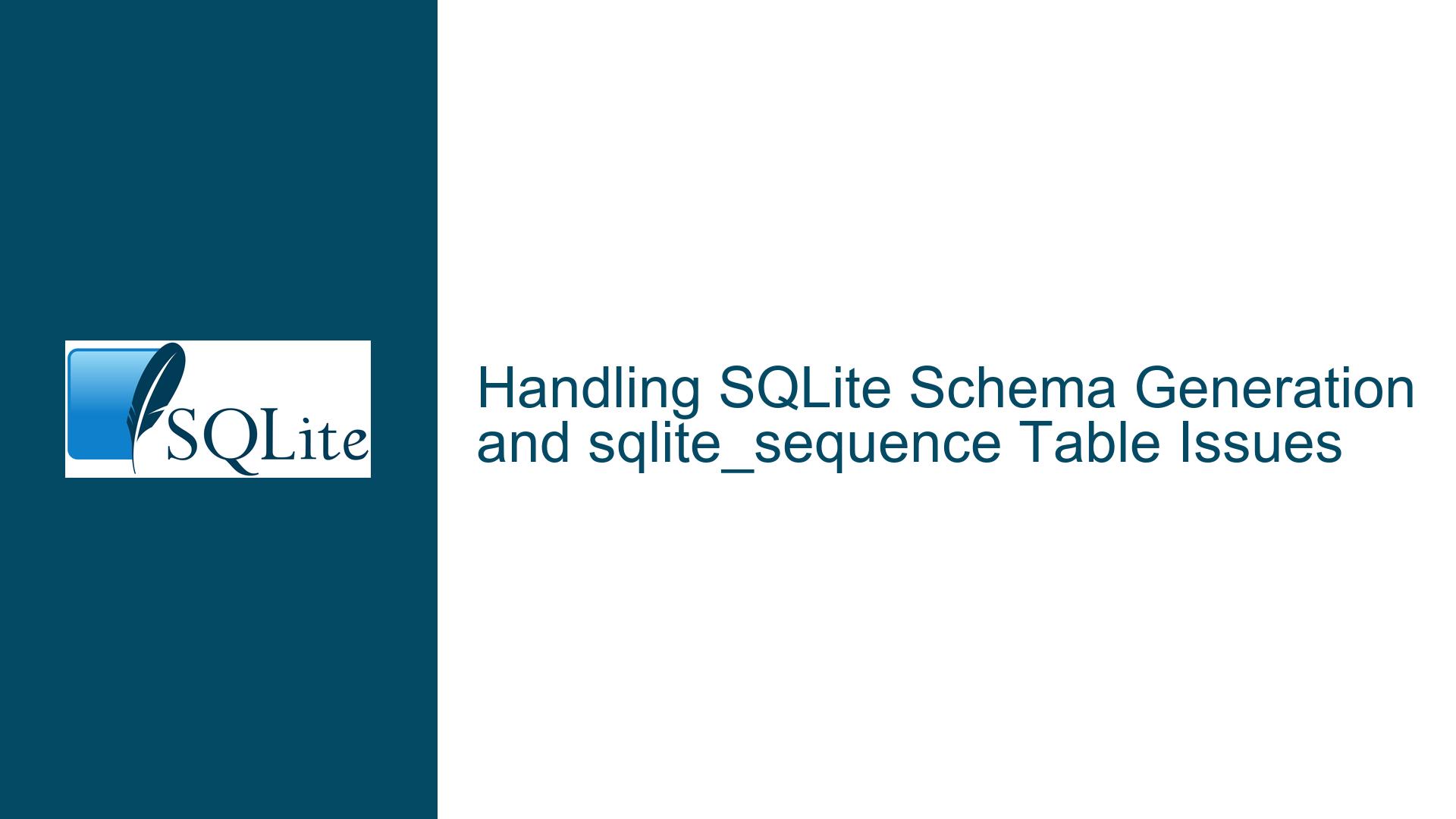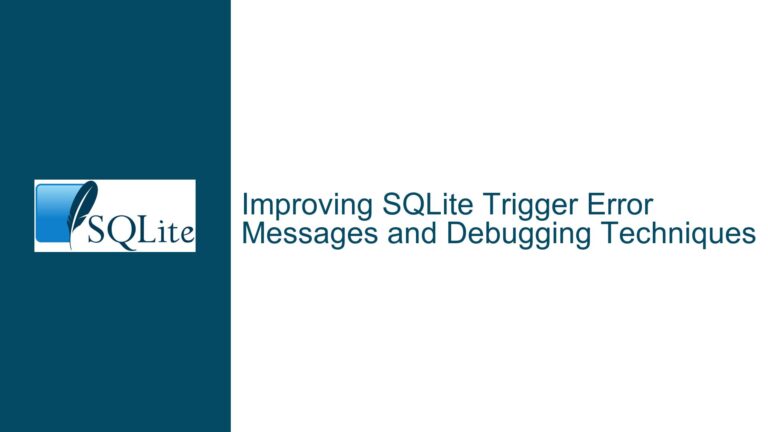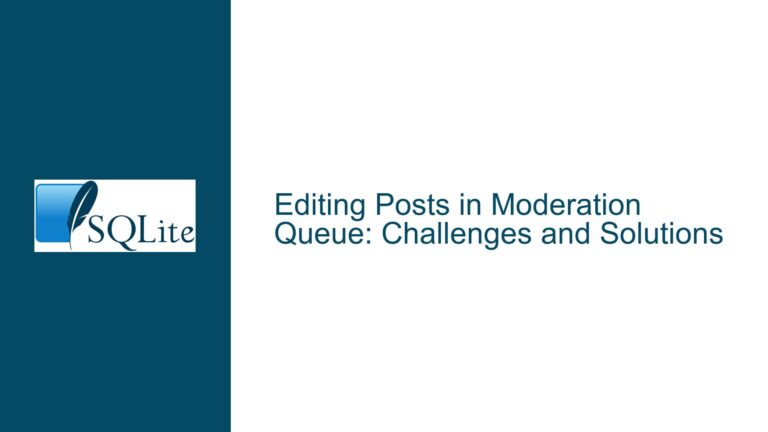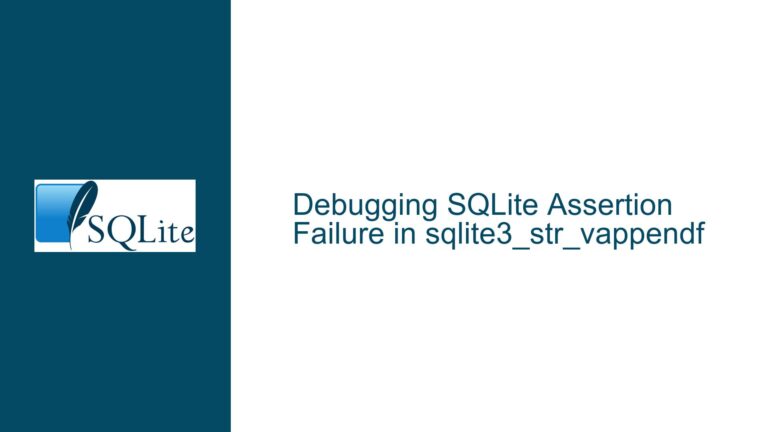Handling SQLite Schema Generation and sqlite_sequence Table Issues
SQLite Schema Generation and sqlite_sequence Table Creation
When working with SQLite, generating a schema from an existing database is a common task, especially when you need to recreate the database structure programmatically. However, one of the challenges that arise during this process is the handling of internal SQLite tables, such as sqlite_sequence. This table is automatically managed by SQLite to keep track of the last auto-incremented value for tables with an AUTOINCREMENT column. The issue at hand is whether the sqlite_sequence table should be included in the schema generation process, and if not, how to effectively exclude it.
The sqlite_sequence table is a special table used by SQLite to store the sequence of auto-incremented values for tables that have an AUTOINCREMENT column. When you create a table with an AUTOINCREMENT column, SQLite automatically creates the sqlite_sequence table if it doesn’t already exist. This table has two columns: name and seq. The name column stores the name of the table, and the seq column stores the last auto-incremented value for that table.
The problem arises when you use tools like sqldiff to generate the schema of an existing database. sqldiff is a utility provided by SQLite that compares two databases and generates SQL statements to transform one database into the other. When you use sqldiff to generate the schema, it may include the CREATE TABLE sqlite_sequence(name,seq); statement in its output. This can cause issues when you try to execute the generated SQL statements to recreate the database, as SQLite does not allow the creation of tables with names that start with sqlite_.
Interrupted Write Operations Leading to Index Corruption
The inclusion of the sqlite_sequence table in the schema generation process can be seen as both correct and incorrect, depending on the context. On one hand, the sqlite_sequence table is part of the database schema, and excluding it might lead to inconsistencies when recreating the database. On the other hand, since SQLite automatically manages this table, including it in the schema generation process is unnecessary and can cause errors when trying to recreate the database.
One of the main reasons why the sqlite_sequence table is included in the schema generation process is that sqldiff is designed to produce a complete representation of the database schema, including all tables, indexes, and other objects. However, this approach does not take into account the special nature of the sqlite_sequence table, which is managed internally by SQLite and should not be manually created or modified.
Another issue that can arise from the inclusion of the sqlite_sequence table in the schema generation process is the potential for errors when executing the generated SQL statements. Since SQLite does not allow the creation of tables with names that start with sqlite_, attempting to execute a CREATE TABLE sqlite_sequence(name,seq); statement will result in an error. This can be particularly problematic when you are trying to programmatically recreate a database from a generated schema, as it requires additional logic to filter out or handle these special tables.
Implementing PRAGMA journal_mode and Database Backup
To address the issue of the sqlite_sequence table being included in the schema generation process, there are several approaches you can take. One approach is to use the SQLite shell’s .dump command instead of sqldiff to generate the schema. The .dump command generates a SQL script that contains the necessary SQL statements to recreate the database, including the schema and the data. However, unlike sqldiff, the .dump command does not include the sqlite_sequence table in its output.
To use the .dump command, you can run the following command in the SQLite shell:
sqlite3 -batch -cmd ".dump" testit.sdb > testit_dump.sql < nul
In this command, testit.sdb is the name of the database file, and testit_dump.sql is the name of the output file that will contain the SQL script. The -batch option ensures that the SQLite shell runs in batch mode, and the -cmd ".dump" option tells the shell to execute the .dump command. The > testit_dump.sql part redirects the output of the .dump command to the testit_dump.sql file, and the < nul part ensures that the shell does not wait for any input.
The .dump command generates a SQL script that includes the CREATE TABLE statements for all user-defined tables, as well as the INSERT statements to populate the tables with data. However, it does not include the CREATE TABLE statement for the sqlite_sequence table, as this table is managed internally by SQLite and does not need to be explicitly created.
Another approach to handling the sqlite_sequence table is to filter out the CREATE TABLE sqlite_sequence(name,seq); statement from the output of sqldiff. This can be done by reading the output of sqldiff line by line and skipping any lines that contain the CREATE TABLE sqlite_sequence(name,seq); statement. This approach requires additional logic in your program to handle the filtering, but it allows you to use sqldiff to generate the schema while avoiding the issue of the sqlite_sequence table.
Here is an example of how you can filter out the CREATE TABLE sqlite_sequence(name,seq); statement from the output of sqldiff:
import subprocess
def generate_schema(database_file):
# Run sqldiff to generate the schema
result = subprocess.run(['sqldiff', 'NULL', database_file, '--schema'], capture_output=True, text=True)
# Filter out the CREATE TABLE sqlite_sequence statement
filtered_output = []
for line in result.stdout.splitlines():
if not line.strip().startswith('CREATE TABLE sqlite_sequence'):
filtered_output.append(line)
# Join the filtered lines into a single string
schema = '\n'.join(filtered_output)
return schema
# Example usage
database_file = 'LTNNetwork.db3'
schema = generate_schema(database_file)
print(schema)
In this example, the generate_schema function runs the sqldiff command to generate the schema and then filters out any lines that contain the CREATE TABLE sqlite_sequence(name,seq); statement. The filtered output is then returned as a single string.
If you prefer to avoid filtering the output of sqldiff, you can also consider modifying the sqldiff tool itself to exclude the sqlite_sequence table from its output. This would require modifying the source code of sqldiff and recompiling it. However, this approach is more complex and may not be feasible if you do not have access to the source code or the necessary tools to recompile sqldiff.
In addition to handling the sqlite_sequence table, you may also want to consider other aspects of schema generation, such as the formatting of the generated SQL statements. For example, you may want to ensure that each CREATE TABLE statement is on a single line, or that the line endings are consistent (e.g., using CRLF or LF). This can be achieved by post-processing the output of sqldiff or the .dump command, or by modifying the tools themselves.
Finally, it is worth noting that the sqlite_sequence table is just one example of the special tables managed by SQLite. Other examples include the sqlite_master table, which stores the schema of the database, and the sqlite_stat1 table, which stores statistics used by the query planner. When generating a schema, you should be aware of these special tables and handle them appropriately to avoid issues when recreating the database.
In conclusion, the inclusion of the sqlite_sequence table in the schema generation process can cause issues when recreating a database, as SQLite does not allow the creation of tables with names that start with sqlite_. To avoid these issues, you can use the SQLite shell’s .dump command to generate the schema, filter out the CREATE TABLE sqlite_sequence(name,seq); statement from the output of sqldiff, or modify the sqldiff tool itself to exclude the sqlite_sequence table. Additionally, you should be aware of other special tables managed by SQLite and handle them appropriately when generating a schema. By taking these steps, you can ensure that your schema generation process is robust and free from errors related to special SQLite tables.






